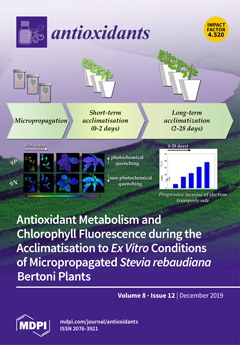The prevalence of hepatic diseases globally and in Egypt particularly necessitates an intensive search for natural hepatoprotective candidates. Despite the traditional use of
Chrysophyllum oliviforme L. and
C. cainito L. leaves in the treatment of certain ailments, evidence-based reports on their bioactivities are
[...] Read more.
The prevalence of hepatic diseases globally and in Egypt particularly necessitates an intensive search for natural hepatoprotective candidates. Despite the traditional use of
Chrysophyllum oliviforme L. and
C. cainito L. leaves in the treatment of certain ailments, evidence-based reports on their bioactivities are limited. In this work, in vivo and in silico studies were conducted to evaluate their methanol extracts potential to alleviate liver damage in CCl
4-intoxicated rats, in addition to their antioxidant activity and identifying the molecular mechanisms of their phenolic constituents. The extracts restored the altered total cholesterol (TC), triglycerides (TG), high-density lipoproteins (HDL), alanine aminotransferase ALT, aspartate aminotransferase AST, total protein, and albumin. Histopathological architecture, DNA fragmentation, and mRNA expression level of TGF-β1 also confirmed the anti-fibrotic activity of the two extracts. The total phenolic content (TPC) in
C. oliviforme ethanol extract exceeded that in
C. caimito. Additionally, the malondialdehyde (MDA), reduced glutathione (GSH), and total antioxidant capacity (TAC) levels assured the antioxidant potential. Seven phenolics; quercetin, isoquercitrin, myricetin, kaempferol, and caffeic, trans-ferulic, and gallic acids were isolated from the ethanol extract of
C. oliviforme. The molecular docking of isolated compounds revealed a low binding energy (kcal/mol with TGF-β1, thus confirming the hepatoprotctive activity of the extracts. In conclusion, the
C. oliviforme leaves could be considered as potent safe raw material for the production of herbal formulations to alleviate hepatic toxicity after preclinical safety study.
Full article






